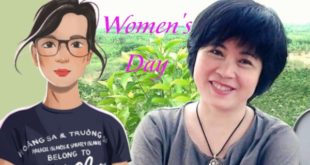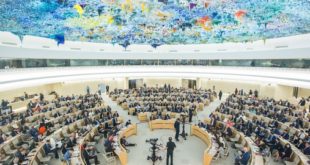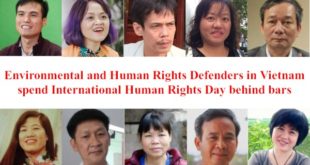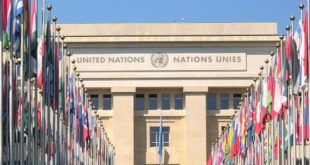PARIS, 6 June 1995 (VIETNAM COMMITTEE) – The Vietnam Committee on Human Rights has just received an important document written by a veteran communist offical in charge of religious affairs which sheds new light on the Communist Party of Viet Nam (CPV)’s policy towards the Buddhist Church. The document, written one year ago, was sent to the Vietnam Committee with the plain inscription: “In offering for the 1995 Vesak Anniversary” (the 2539th Anniversary of the Birth of Buddha). There was no indication as to whether it was sent by the author himself, Mr Do Trung Hieu, or by another source. The author’s address – 7D Phung Khac Khoan Street, 1st Ward, Ho Chi Minh City – is mentioned in the text.
Do Trung Hieu, code-name Muoi Anh, was born in Khanh Hoa, Central Viet Nam. Before 1975, he was head of the Tri Tre Department (Mobilisation of Intellectuals, Students and Youth) for the Saigon-Gia Dinh area, under the direct orders of Tran Bach Dang. After 1975, he was appointed by Xuan Thuy (1) to head the “Mission to Unify Buddhism”. Maintained at this post by Xuan Thuy’s successors Nguyen Van Linh, then Tran Quoc Hoan, Do Trung Hieu became the principal architect of the Party’s policy to neutralise Vietnamese Buddhism, a policy which culminated in the creation of the State-sponsored Viet Nam Buddhist Church in Hanoi on November 4th 1981.
The document, entitled “The Unification of Vietnamese Buddhism”, comprises 50 type-written pages of comments and analysis on the CPV’s strategy to neutralise – and finally to suppress – the Unified Buddhist Church of Viet Nam (UBCV), and reveals valuable inside information such as the names, functions and influence of all those involved with this affair on both the Buddhist and Communist sides.
The document describes the CVP’s long-standing hostility towards Buddhism, and the consequences of this policy in North Viet Nam. Xuan Thuy t old the author that, as a result of Directive No 20 drawn up by Tran Xuan Bach and signed by Party Secretary Le Duan in 1960:
“in the north, Buddhist followers have all joined mass organisations, only old people (…) go to Pagodas to worship nowadays” and “bona-fide monks are few and far between”. In short, said Xuan Thuy, even the most prominent communist figures of Buddhism such as the “inevitable” Venerable Pham The Long, or Venerables Thien Hao and Minh Nguyet (all members of the CPV, according to Mr Hieu), have an “extremely limited” understanding of Buddhism and “are unable to respond to followers’ needs”.
In contrast, Mr Hieu quotes Xuan Thuy’s appraisal of the Unified Buddhist Church head-quartered at An Quang Pagoda: “[the UBCV] is not only a religious organisation of national proportions, but it is also a socio-political organisation with a wide-based popular following, significant international renown and a leadership of remarkably talented monks”. Xuan Thuy warned that “if the unification process follows the proposal of Venerable Thich Don Hau, i.e. that the Buddhist Patriots’ Liaison Committee (BPLC) is disbanded, and the Unified Buddhist Association (UBA) (2) is incorporated into the Unified Buddhist Church of Viet Nam and comes under UBCV leadership, the UBCV’s influence will spread all over the country, and not just be contained in South Viet Nam as before 1975”.
Xuan Thuy feared that if the UBCV was allowed to develop along these lines, “the Party would never be able to control the UBCV. On the contrary, the UBCV would become an enormous, popular, religious organisation which, with its mass following of Buddhists, would constitute a permanent challenge for the Party and the government”.
In fact, as Do Trung Hieu explains, the real objective behind the policy of Buddhist “unification” advanced by the CPV and its Mass Mobilisation Department was to “transform Vietnamese Buddhism into a people’s association. Its structure should be inferior to that of an ordinary association, restricted exclusively to monks and nuns without any participation of lay-followers – a top-level structure without any popular structural base. We shall call it the “Vietnamese Buddhist Association [VBA]”.
By restricting it within the limits of this association, the CPV’s intent was to prohibit Buddhism – and thence the UBCV – from playing any social role: “Its [the VBA’s] activities should be confined exclusively to the celebration of religious ceremonies and worship in Pagodas. It must on no account be allowed any activities related to society or to the people (…) Only Pagodas will be allowed to serve as the Association’s bases or headquarters. Thus, the mass following of Buddhist laity will never be allowed to structure its forces into organic units of the Church”.
Following Xuan Thuy’s admission – implicitly that of communist authorities – that “the only thing the monks of the [communist] Unified Buddhist Association and the Buddhist Patriots’ Liaison Committee will be able to do will be to “carry the briefcases” of the UBCV”, and that “Venerable Thich Tri Quang will scoop them all up in a sweep of his sleeve”, the CPV’s only way of maintaining control was to set up a State-sponsored body, the Viet Nam Buddhist Church on November 4th 1981. Ostensibly an umbrella for the “unification” of Vietnamese Buddhism, the VBC was conceived to supplant the UBCV.
Do Trung Hieu affirms that the establishment of the VBC was the work of the CVP alone: “Out of the nine organisations and Buddhist schools attending the Congress (3), one belonged to the UBCV, whereas the eight others were all under the direct control of the Party (…). To preserve appearances, the task of unification was handled by Buddhist monks, but the Party’s control and its determination to transform Vietnamese Buddhism into a puppet of the CPV was obvious throughout the whole reunification process”.
Thanks to Mr Hieu’s revelations, the motivations behind the systematic campaign of repression launched by the communist authorities against the UBCV after 1975 become clear. This repression reached such a height that on November 2nd 1975, twelve monks and nuns burned themselves alive in protest at Duoc Su Pagoda in Can Tho. Repression and protests continue today, with a sharp escalation of tensions over the past three years (continued arrests of nuns, monks and Buddhist lay-followers; repression against the demonstration of 40,000 Buddhists in Hue on May 24 1993; clamp-down on the UBCV rescue mission for flood victims in the Mekong Delta in November 1994; arrests of Patriarch Thich Huyen Quang in December 1994 and Secretary General Thich Quang Do in January 1995).
The UBCV’s former Patriarch Thich Don Hau was taken into the maquis by the communists after the 1968 Tet Offensive, then transferred to Hanoi, where he was made Adviser to the Provisional Revolutionary Government of South Viet Nam. In 1976 he became a Member of the National Assembly and Member of the Executive in the Central Committee of the Fatherland Front. However, he resigned from all these functions in protest against the Government’s repression of the UBCV. According to Mr Hieu, the Patriarch “maintained this position until the day of his death” on 23 April 1992.
His “position” was, in Mr Hieu’s words, an open and energetic opposition to the Government’s policy of transforming Buddhism into a tool of the CPV. Mr Hieu recalls that “immediately after the liberation [of South Viet Nam]” in 1975 Thich Don Hau sent a Petition along these lines to Le Duan, Ton Duc Thang, Truong Chinh and Pham Van Dong . In response, “the Party [turned down] Thich Don Hau’s proposals for Buddhist reunification and [accused] the Patriarch of harbouring evil intentions against the Party and the Vietnamese Government”.
Mr Hieu’s document also sheds light on the position of one of the UBCV’s most enigmatic figures, the Very Venerable Thich Tri Quang. Giving an insight into Thich Tri Quang’s 20-year long silence, during which he has refused all cooperation with the communist authorities and taken no part in the Party’s “Buddhist Unification” operation, Mr Hieu reveals the four basic conditions set down by Thich Tri Quang for the unification of Buddhism in Viet Nam:
1. “On the religious level, unifying Buddhism means developing the fundamental essence of Buddhism, i.e. Knowledge, Liberation of Being, and the respect for the monastic practices of the different schools” such as Hinayana (Small Vehicle) and Mahayana (Great Vehicle) Buddhism, both of which are practiced in Viet Nam;
2. “On the organisational level, unifying Buddhism means establishing one religious body which has moral and legal authority both inside and outside the country”. Local structures and “different schools should retain their own monastic practices” whilst respecting the directives of the central religious institution;
3. “On the social level, unifying Buddhism means conducting all Buddhist social activities under the directives of one central Church. This Church must be independent, and its doctrines must faithfully adhere to teachings and precepts of Buddha;
4. “On the executive level, unifying Buddhism means giving the Church freedom to appoint its leadership in a just and equitable manner, without compliancy, free from any political pressure (…). Leaders of the Sangha [community of monks and nuns] must be selected on the basis of their spiritual and moral authority alone, and their appointment should be approved by the entire Buddhist Sangha as well as by followers all over the country”.
These proposals were flatly rejected by the Party’s leaders, who remained hostile to the UBCV and wary of Thich Tri Quang’s considerable influence. Indeed, the CPV perceived Thich Tri Quang as a formidable adversary, as Mr Hieu reveals in a comment made by Muoi Ut (Nguyen Van Linh’s code- name) to Tu Anh (Tran Bach Dang’s code-name): “The National Liberation Front (NLF) has never been defeated by anyone, but Thich Tri Quang outwitted them three times running. Each time, in the subtlest possible way, Thich Tri Quang rescued the Americans and their puppets (sic)”.
Nguyen Van Linh was referring to three campaigns launched by Thich Tri Quang in 1964 and 1965, which the communists believed were deliberately directed against them. He recounts:
“In 1964, there was severe flooding in Central Viet Nam. NLF fighters were about to take over the puppet army’s outposts, when Thich Tri Quang launched the slogan “Unified Buddhist Church of Viet Nam Rescue Mission”. With the five-coloured [Buddhist] flag floating on the dinghies, boats and helicopters, [the NLF soldiers could not attack] and the soldiers of the puppet army were saved”.
Later, “in the same year, 1964, popular protests broke out against the puppet regime. The NLF sought to step up this movement in the cities by launching anti-government slogans. Thich Tri Quang chose that very moment to create the “People’s Council for National Salvation” in Central [Viet Nam]” and demand a civilian government. This attracted the whole population’s attention to him, and our slogans were totally eclipsed”.
Finally, “in 1965, [after] the American army had cynically invaded South Viet Nam, the NLF stepped up revolutionary warfare against the American imperialist aggressors. Thereupon, Thich Tri Quang launched the “Prayer for Peace” operation, which totally compromised [the NLF’s] anti-american war efforts.”
Do Trung Hieu gives his own view on the CPV: “The Politburo is a collectivity which operates as “every-man-for-himself” under the directives of the Secretary General. The Party Secretariat is another collectivity which operates as “every-man-is-king-of-his-own-castle” under the orders of the Secretary General. As for the Secretary General, he incarnates democratic centralism. This makes for the worst possible kind of dictatorial, feudal regime”. He also gives the views of other Party members, such as Mr Nguyen Huy Quang, a cadre in charge of mass mobilisation and religious affairs in the North, who bitterly commented: “This is not our Party, it’s theirs, and theirs alone, even though we are members of it. For all that we are [Party] members, we are nothing but pawns in their game”.
Do Trung Hieu concludes with the analysis that the CPV’s failure in economic management, which has lead the nation to bankruptcy, is nothing in comparison with the irreparable damage it is wreaking in the religious domain. He calls on the CVP to cease all interference in religious affairs: “When a company manager loses millions of dongs through mismanagement, he causes worry and hardship, but he can always find a way to earn back the loss. But in the [religious] domain, the slightest mistake can cause irreparable suffering for millions of people, especially all those who are in jail, who die in prison or in deportation. Nothing can replace such losses or repair such mistakes. I urge you to give this question serious thought and elaborate a project that fits the people’s aspirations, working on the principle that one must “render unto Caesar the things which are Caesar’s”. (…) You cannot continue with policies that bring such harm the Nation and engender so much suffering to the mass of [religious] followers. For if you do, you will bear full responsibility and must take whatever consequences are to come”.
The full text of Do Trung Hieu’s document is available here (in Vietnamese).
(1) Head of the North Vietnamese delegation to the Paris Peace talks in the late 60s, Secretary of the CPV Central Committee, Head of the Mass Mobilisation Department and of the Fatherland Front, Party Secretary and Secretary of Mass Organisations in the Fatherland Front’s Central Committee.
(2) The UBA was the Buddhist organisation for North Viet Nam, the BPLC for the South.
(3) The Congress in Hanoi in 1981 at which the Viet Nam Buddhist Church was founded.
 Quê Me Quê Me: Action for democracy in Vietnam & Vietnam Committee on Human Rights
Quê Me Quê Me: Action for democracy in Vietnam & Vietnam Committee on Human Rights




